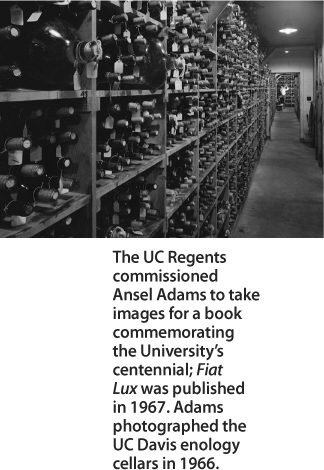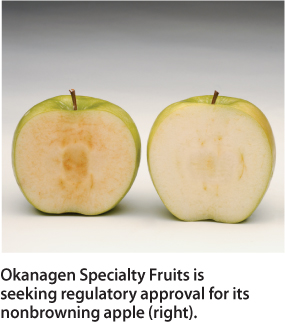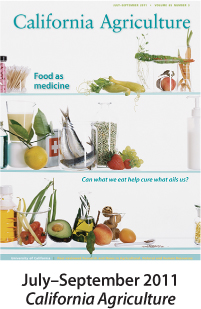All Issues
Letters
Publication Information
California Agriculture 66(3):81-84.
Published online July 01, 2012
PDF | Citation | Permissions
Full text
RSVP
WHAT DO YOU THINK?
The editorial staff of California Agriculture welcomes your letters, comments and suggestions. Please write to us at: 1301 S. 46th St., Building 478-MC 3580, Richmond, CA 94804, or calag@ucdavis.edu . Include your full name and address. Letters may be edited for space and clarity.
More on Morrill
I enjoyed the latest issue of California Agriculture with emphasis on the Morrill Act (“The Morrill Act at 150: How a land-grant law launched the University of California,” April-June 2012). I have spent my entire college training and professional career at land-grant universities, but I knew only the basics of the important legislative acts affecting them. So with extra time after retirement, I began to learn more about the background of these important laws.
I'm sure that most of my colleagues don't know that there are 107 land-grant institutions in the United States, that a 1994 act added more than two dozen Native American institutions to the total, that MIT is a land-grant university, or even that Rep. Morrill almost certainly was not the author of the Morrill Act of 1862, although he did yeoman's service in getting it passed.
I have written up my findings (see http://ucanr.org/u.cfm?id=46 ) and shared them with various people on my campus. I am not a historian and this is not an authoritative scholarly work, but I believe it is accurate. I believe the Morrill Act of 1862 was one of the most influential events in the history of education in the world.
Arnold P. Appleby, Professor Emeritus Crop Science, Oregon State University, Corvallis
UC President Mark G. Yudof presented an excellent overview (“For 150 years, UC science and agriculture transform California,” April-June 2012). He concluded that without the Morrill Act, UC might not have evolved into world's greatest public university system, which led California agriculture to a $37.5 billion industry. President Yudoff credited Justin Smith Morrill, who proposed the federal land-grant system, which was endorsed by President Lincoln, who signed the Morrill Land-Grant College Act of July 2, 1862.
Your readers will be enlightened to learn that Rep. Morrill left school at the age of 15! He attended commons schools in Vermont: Thetford Academy and Randolf Academy. He never went to college, since his father could not afford to send him for further education. However, his school foundation enabled him to lead the people of Vermont in the U.S. Congress for 12 years, from 1885 to 1867. Later he became a U.S. senator for over 30 years. He died in 1898 while in office. The University of Pennsylvania gave him an honorary degree for his work as a congressman.
Dilipsinh M. Gaekwar, Mendham, N.J.
Morrill Act inspires
I appreciated the article in the current publication that reviews the history of land-grant colleges, beginning with President Lincoln (“UC's land-grant mission fuels nation's growth, prosperity,” by Rose Hayden-Smith, April-June 2012). I cannot imagine where the United States would be without well-funded agricultural research and technology from lab to field. UC has been a major leader, and it's interesting to know how it has influenced agriculture around the world and the topics that are crucial for food production and healthy natural resources. Thank you, California Agriculture and the editorial staff, for sharing.
Karen Sweet, Rancher and Steering Committee Member, California Rangeland Conservation Coalition
I am here in Pakistan on a project to help Pakistan and Afghanistan develop an extension service. I brought a number of the current issue to share with colleagues and our trainees. I thought it was excellent, especially the specific details of Lincoln and the South's secession aiding passage of the Morrill Act.
Louise Ferguson, Cooperative Extension Specialist, Department of Plant Sciences, UC Davis
UC Riverside history clarified
The UC Riverside College of Natural and Agricultural Sciences dean's office just received the magnificent April-June 2012 issue. I hasten to send congratulations to all who had a hand in it. I especially enjoyed Rose Hayden-Smith's review of the effects of the Morrill Land-Grant College Act, a piece of legislation whose importance to American higher education is matched (perhaps) only by the GI Bill.
I must draw your attention to a mistake in your timeline — a rather serious one from our point of view. On page 47 you write, “The [Citrus Experiment Station] became UC Riverside in 1959.” Actually, UC Riverside was founded in 1954.
This error may have come about by a too-rapid reading of the UC Riverside website. The history presented at www.ucr.edu/about/history.html states, “In 1948, the University of California Regents approved the establishment of the College of Letters and Science. The college opened for classes in February 1954. In 1959, Riverside was declared a general campus by the Regents and courses of study began to be developed.”
It would be easy to focus on that 1959 date since the earlier date is submerged, both physically and syntactically. Our timeline ( www.ucr.edu/about/timeline.html ) outlines the development of UC Riverside. A small liberal arts college was established in 1954 as UC Riverside, which the Regents intended as an alternative to the other comprehensive UC campuses. That model was not successful, and 5 years later the Regents reorganized UC Riverside as a general campus.
It is important that the readers of California Agriculture know the second most important date in UC Riverside history — the first, of course, being the foundation of the Citrus Experiment Station in 1907.
Sara Clausen, Director of Communications, College of Natural and Agricultural Sciences, UC Riverside
Publication numbering update
The photos are wonderful — an incredible collage for the different eras. I had not realized that UC Riverside had those Ansel Adams photos. The choices were diverse, such as those from the Fritz-Metcalf collection.
The UC Regents commissioned Ansel Adams to take images for a book commemorating the University's centennial; Fiat Lux was published in 1967. Adams photographed the UC Davis enology cellars in 1966.
There was one minor typo on the very last page that caught my eye, since I am familiar with publication numbering. An ad for the Organic Winemaking Manual is listed as ANR Pub No. 5311, but it's actually 3511.
I know how much work went into this issue. Congratulations!
Norma Kobzina, Interim Head, Marion Koshland Bioscience and Natural Resources Library, UC Berkeley
The legacy of black agriculture in California
Sept. 9, 1850, Admission Day for the state of California, provided an economic infusion into the U.S. economy; fueled by the Gold Rush, this event helped to provide capital for technological change including transcontinental transportation and public education. President Abraham Lincoln was elected in 1860; in the midst of the Civil War, a slate of 1862 farm legislation passed Congress because there was no Southern block to influence U.S. farm policy.
Prior to the Emancipation Proclamation, President Lincoln wrote in September 1862, “If I could save the Union without freeing the slave, I would do it, and if I could save it by freeing all the slaves, I would do it, and if I could do it by freeing some and leaving others alone, I would also do that.” Lincoln's object was to save the Union, and he chose the latter.
California must expand the equitable allocation of resources to include a renewed recognition of the contributions — past, present and future — of people of African ancestry to the landscape.
These hidden contributions must come to light. We have earned recognition as catalysts for inclusive partnerships that began with the creation of the first public school and continue with UC participation.
On April 28, we co-hosted, with Tarlesson Farms, a groundbreaking ceremony for our Black Agriculture Regional Center in historic Guinda, in the Capay Valley. On May 25, we celebrated Africa Day and passage of Senate Resolution 31 at the State Capitol in Sacramento.
The California Black Agriculture Working Group will continue raising awareness of challenges, as well as progress made, in restoring agriculture as the foundation of black culture.
Michael Harris, Chairperson, California Black Agriculture Working Group Sacramento
Editor's note: The U.S. Department of Agriculture Office of Advocacy and Outreach offers programs to improve access to services for historically underserved communities, increase the viability and profitability of small and beginning farmers and ranchers, provide agricultural opportunities for farmworkers, and close the professional achievement gap by providing opportunities to talented and diverse young people. For more information go to www.outreach.usda.gov and www.outreach.usda.gov/USDALocalOffices.htm .
Name that fruit
Regarding the picture on page 64 of the April-June 2012 California Agriculture labeled “plums”: it looks like prunes to me because it has a flat pit or stone.
I am confounded by the modern uses of the words “prunes” and “plums.” For the last 80 years I have been told there is a difference between the two. Prunes are freestone fruits. Plums are clingstone fruits. Prunes can be dried with the pits. Plums cannot be dried with the pits. To buy these trees you must ask the nursery for either prune trees or plum trees.
I have a difficult time telling the grocery stores to list my ‘Brook’ prunes as prunes. The stores try to compromise and call them prune plums.
If the prunes I grow and sell are to be called plums, then other members of the Prunis genus might as well carry that label as well: apricots, peaches, cherries and almonds.
In Oregon, the filbert nut is now called a hazelnut for marketing purposes, so that may be the case with plums. Back in the 1800s and 1900s, the foothills of the Willamette Valley raised a lot of prunes. I have government bulletins referring to production from 1927, 1931, 1954, 1962, 1968 and 1982. I see ads from California for dried prunes and prune juice.
I would like to see the correct use of prunes and plums, whatever that is. Thank you for the good articles. Keep them accurate and scientific.
There is an old saying, “full of prunes,” meaning to talk nonsense. Maybe I am full of prunes.
Glen Mills, Mills Organic Farm, Newberg, Oregon
Theodore DeJong, UC Cooperative Extension Pomologist, responds: Technically prunes are plums that are used for drying. Specific plums that will dry without fermenting when laid in the sun can also be called prunes. In the commercial trade in most countries, plums used for drying can be called prunes whether they are actually sold fresh or dry. In California, dried prunes have been marketed as dried plums to get away from the idea that they are only for old people who need a laxative. It has nothing to do with being freestone or clingstone.
Labeling biotech crops
Regarding “Research and adoption of biotechnology strategies could improve California fruit and nut crops,” by Haroldsen et al. (April-June 2012): Can California Agriculture disprove the alleged health and environmental risks of genetically modified organisms (GMOs)? We are supporting a “label GMOs” initiative in California, to require all producers to label their products. If the GMO developers and seed manufacturers are confident and proud of their product, why are they spending millions to stop the initiative? Of course this would include transgenics. We buy only organic and are budding organic farmers.
Vazik and Janet Avedisian, Arroyo Grande
Lead author Victor Haroldsen and coauthors respond: As we cited in our article, genetically engineered (GE) crops have provided “a reduction of 86.2 million pounds (10.2%) of pesticide usage and proffer[ed] an associated 21.8% reduction in the environmental impact quotient.” These are demonstrable benefits that should resonate with organic consumers and budding organic farmers. Unfortunately, there is a wide philosophical gap between organic and conventional farmers when it comes to GE crops, even though there is a shared interest in producing safe food with reduced environmental impacts. Mandatory labeling of GE foods in California will present yet another hurdle to the commercialization of improved fruit and nut crops that could be beneficial to California's economy and, in one more way, create a regulatory barrier to innovation in the state.
Switchgrass and CDFA
Regarding “Switchgrass clarification” (Letters, April-June 2012): While switchgrass is no longer on the California Department of Food and Agriculture (CDFA) noxious weed list, it was included as a B-listed species in 2007 (see CDFA's Noxious Times 8(4):1–9). Interestingly, the plant has never been shown to be invasive in California, where it is not native, but it was placed on the list because of the proposed planting of large acreages as a biofuel species. By putting switchgrass on the state's noxious weed list, CDFA was then able to prevent large-scale cultivation until they were assured that it did not have high potential to become an invasive species. In fact, our lab was involved in those studies. By 2010, switchgrass had been removed from the state noxious weed list. In support of this, our research results showed that it has a very low potential to become invasive in the state.
Joseph DiTomaso, Cooperative Extension Weed Specialist, Department of Plant Sciences, UC Davis
Seaweed as a source of omega-3 fatty acids
Regarding “Food as Medicine” (July-September 2011): The authors must be aware of the sources of omega-3 fatty acids. Seaweed salad from Korea solves the problem without using fish. I consume some with my nopalitos for breakfast every morning. The public should be aware of this source of omega-3 fats.
Andrew A. Benson, Scripps Institution of Oceanography, UC San Diego
Angela Zivkovic, author of “Dietary omega-3 fatty acids aid in the modulation of inflammation and metabolic health” (July-September 2011), responds: While seaweed (wakame) is a source of omega-3 fatty acids, it contains modest amounts. According to the U.S. Department of Agriculture nutrient database, there are 186 milligrams of eicosapentaenoic acid (EPA) per 100 grams of raw seaweed. This is one-third of the amount in an equivalent portion of raw pink (wild) salmon. There is even less in dried seaweed: 87 milligrams EPA per 100 grams. An entire package of dried seaweed usually contains 100 grams of seaweed, which is typically not consumed by one person in 1 day.










